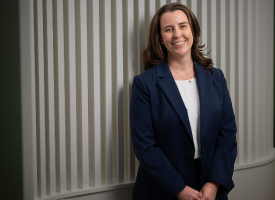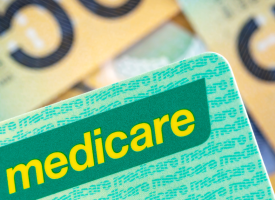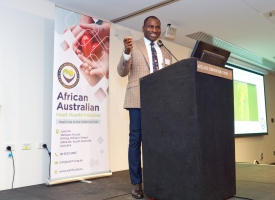Real time hospital data must reflect patient experience
Real time emergency data is crucial to driving effective reform and the effective allocation of resources, but it must reflect the reality of the patient experience, AMA Queensland President Dr Nick Yim told 4BC Radio. "We do need the data portal to be accurate and transparent, and provide what patients and clinicians need to make their clinical decision."

Transcript: AMA Queensland President Dr Nick Yim, 4BC Radio, Breakfast with Peter Fegan, Wednesday 14 May 2025
Subjects: Real time hospital data
PETER FEGAN: One of the key changes in the Crisafulli Government's approach to fixing Queensland's health system has fallen short of the mark. In February, Open Hospitals was launched, providing real-time data on wait times and patient numbers in emergency departments, promising it would fix the state's health crisis. Now, I've always maintained that I don't know how real-time data fixes the health crisis at all – all it does is provide us with more context on how bad things are. But the average wait time in Queensland EDs remains at 14 minutes, the same number from the October to February period. So, it hasn't improved. There are also concerns that the data being displayed on Open Hospitals is not really a reflection of the patient experience.
So, here to discuss it a little further is AMA Queensland President Dr Nick Yim. Doctor, thanks for your time this morning.
DR NICK YIM: Good morning.
PETER FEGAN: So, Doc, how does real-time data help to fix the hospital system? I don't understand it.
DR NICK YIM: To start off, three months ago we welcomed the new real-time data portal. We know that with everything we do, data is important. How many people are waiting in the wait rooms? How many people are waiting in beds? How long people are waiting for outpatient? How long people are waiting for surgeries, for example? So, if we have health data, we know how many staff we're short – whether it be doctors, nurses – and how many hospital beds we need. To help us allocate the resources, that's the main reason why health data is so important.
PETER FEGAN: Okay. So, the data that's been released this morning, or the data that's now been made available – 70,000 people have used the site in three months. Is that reflective of the entire system, do you feel?
DR NICK YIM: I don't think it's a reflection of the true system, but as you alluded to earlier, I think we do need the data portal to be accurate and transparent, and provide what patients and clinicians need to make their clinical decision. As you alluded to, when there's not much change in the wait times in the data portal, that can lead to frustration, and we're hearing that, unfortunately, in our emergency departments.
PETER FEGAN: So, what are we seeing today? What have been the major issues within our health system? Is it a nurse shortage? Is it a bed shortage? I mean, you've still got the average wait time at what, 14 minutes? Is that correct in ED? That doesn't seem bad to me though, 14 minutes, does it?
DR NICK YIM: Yes, but the reflection there is that when we speak to patients, when we speak to nurses, when we speak to doctors, we know when someone walks into an emergency department, especially at the Royal Brisbane or some of the big tertiary hospitals, they probably will be waiting in the waiting room for more than 14 minutes.
PETER FEGAN: I was going to say, you can't tell me the average wait time in Queensland remains at 14 minutes. There's no way on this earth that someone walks into an ED of a Brisbane hospital and sits there for just 14 minutes before being seen. I don't buy that at all.
DR NICK YIM: That's the communication that we need with our community and our patients. That 14 minutes, that data, that's basically when the patient presents to emergency and triage at the front desk to determine how severe their illness is. So, data is important, but what we hear from our community is they want to know how many beds are available, how long are they going to wait to get to the back of the shop, for example. So those are key things.
PETER FEGAN: So that's a bit of a fib, Doctor, isn't it? This is not on you, but that's a bit of a fib, isn't it? If you walk into an ED and you get seen by a triage nurse, that's not being seen to. That's waiting in line until you're seen by a doctor.
DR NICK YIM: And that's the key thing – that's what we're communicating with the Queensland Government. We want to change that data, to change that metric, because what we're hearing is, obviously, patients are frustrated.
PETER FEGAN: It's ridiculous. It's not accurate. It's silly to think that you're going to wait 14 minutes. It's not true. It's not a reflection of the truth and I think that's where the government is getting this wrong. I think what it's trying to do is cover up the real issues. I know that they inherited a mess from the Labor Government, and I know that David Crisafulli and the LNP have only been in for, what, six or seven months. But you can't tell me that 14 minutes is the wait time. If I ask people listening to me this morning, Doctor, if they've been waiting longer than 14 minutes, I guarantee you what the answer is going to be. So that's not a reflection of the truth. Are these some of the things within this data that you're not happy with?
DR NICK YIM: Yes, I think we just need to tweak it. We need to ensure that it's useful so it's beneficial for the whole health industry. One of the key things that you highlighted earlier is, there's a Queensland budget coming up and it's a really great opportunity for the state government to invest in our healthcare system moving forward. One of the big challenges that we're hearing is health workforce – that's doctors, nurses, allied health, pharmacists, administration staff. We need to invest in the Queensland workforce so we can service the Queensland community. That's something that we do need to work on, and I think if we can invest in our workforce, that means we can potentially improve that treatment time.
PETER FEGAN: When Dr Maria Boulton was the AMA Queensland President, she used to say you needed about 2,000 serviceable hospital beds in Queensland to keep up with the demand, an additional 2,000. How are we going with hospital beds, have we got any more?
DR NICK YIM: That's something else that we're working on. Obviously, there is a commitment from the current government to invest in hospital beds and we're going to hold them to account for those because we know that our population has grown. Our population is growing older, so we need those hospital beds to come online.
PETER FEGAN: How many [new beds] have we had since they've been in office?
DR NICK YIM: I'll have to check my data on that one. I'm not too sure.
PETER FEGAN: Okay. If you can, that'd be great. We'd love to find out. I mean, again, they're only just getting started and I understand that, but I mean, to sit there and to suggest to Queenslanders that you're waiting 14 minutes to see a doctor or to be treated at a hospital is a load of BS. We know that AMA Queensland made a formal recommendation to the government on improving the portal. Some of the improvements would be to stop being so frivolous with the truth, I suggest.
DR NICK YIM: That's the key thing – it's being completely transparent. I'm a GP and I know when I'm transparent, when I speak to my patients, I give them the full truth. I tell my patients, when people are waiting for outpatients, for example, there is going to be a bit of a wait. People are happy to know that when you tell them the truth, they're aware of it and it's setting the expectations for the general public.
PETER FEGAN: What about the, dare I call them, satellite hospitals that have now been renamed – are they helping?
DR NICK YIM: It's really hard to say. Obviously, the data is really in early phases. It's welcome that we have changed the name, so it's minimised some confusion there. At the start when we spoke earlier, there was an element of confusion, but that's something we continue to educate the public on. We continue to work with the Queensland Government and it’s so important to have that relationship.
PETER FEGAN: Well, good on you, Doctor. Lovely to have your company this morning, and you're right, and good on AMA Queensland for calling it out. I'm not, for one moment, suggesting that the government isn't doing anything about this. What I'm suggesting to the government is to start telling the truth. I mean, 14 minutes to see a doctor, that's only one of the fibs that I can see within the data. 14 minutes - that's nowhere near accurate and I think if the government wants people to trust it, that it can fix the health system, it's got to tell the truth a little more.
DR NICK YIM: Yes, and we acknowledge that. It's going to be a long-term fix, which is the reason why we need this Queensland Budget to invest into the future and to ensure that we do have a sustainable healthcare system.
PETER FEGAN: Exactly. Good on you, Doctor. Thanks for your time this morning.
DR NICK YIM: Always a pleasure.



